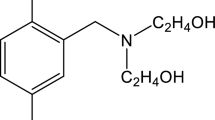Summary
Vanadium(V) in aqueous HCl, HNO3 or H2SO4 solutions is extracted with 2-carbethoxy-5-hydroxy-1-(4-tolyl)-4-pyridone (HA) dissolved in CHCl3 and determined spectrophotometrically. Depending on the composition of the aqueous phase, two complexes are formed. At pH 1 (HCl, HNO3, H2SO4) VO2A(HA)2 is formed with maximal absorption at 478 nm. However, from 4–5 M HCl, VO2Cl(HA)3 is extracted, and has maximal absorption at 615 nm. The same complex is extracted from 2–3 M HNO3 or 3–4 M H2SO4 if enough chloride is added. Solutions of both complexes follow Beer's law and the molar extinction coefficients are 4.15 × 1031 · mole−1 cm−1 at 478 nm and 5.10 × 103 at 615 nm. The determination of vanadium at both wavelengths is very simple, fast and selectiv.The composition of the complexes was established by the usual methods as well as by characterization of the isolated crystalline compounds by elemental analysis and infrared spectroscopy.
Zusammenfassung
In Salzsäure, Salpetersäure oder Schwefelsäure gelöstes Vanadin(V) wird mit 2-Carbäthoxy-5-hydroxy-1-(4-tolyl)-4-pyridon (HA), gelöst in Chloroform, extrahiert und spektrophotometrisch bestimmt. Je nach der Zusammensetzung der wäßrigen Phase werden zwei verschiedene Komplexe gebildet. Bei pH = l (HCl, HNO3, H2SO4) entsteht VO2A(HA)2 mit einer maximalen Absorption bei 478 nm. Hingegen geht aus 4- bis 5-m HCl-VO2Cl(HA)3 in den Extrakt über, das bei 615 nm maximal absorbiert. Der gleiche Komplex läßt sich auch aus 2- bis 3-m HNO3 oder aus 3- bis 4-m H2SO4 extrahieren, sofern man genug Chlorid zusetzt. Die Lösungen beider Komplexe entsprechen dem Beerschen Gesetz; der molare Extinktionskoeffizient beträgt 4,15 · 103 1 · mol−1 cm−1 bei 478 nm und 5,10 ·103 bei 615 nm. Die Vanadinbestimmung ist bei beiden Wellenlängen sehr einfach, rasch und selektiv. Die Zusammensetzung der Komplexe wurde in üblicher Weise ermittelt, außerdem auch durch Elementaranalyse und IR-Spektroskopie der isolierten kristallisierten Verbindungen.
Similar content being viewed by others
References
M. Janko and M. J. Herak, Croat. Chem. Acta,43 179 (1971).
M. J. Herak, M. Janko, and K. Blažević, Croat. Chem. Acta41, 85 (1969).
M. Janko and M. J. Herak, Mikrochim. Acta [Wien]1972, 198.
M. J. Herak and M. Janko, J. Inorg. Nucl. Chem.34, 2627 (1972).
M. J. Herak, M. Janko, and B. Tamhina, Mikrochim. Acta [Wien]1973, 783.
M. J. Herak, B. Tamhina, and K. Jakopčić, J. Inorg. Nucl. Chem.35, 65 (1973).
K. Blažević and V. Hahn, Croat. Chem. Acta38, 113 (1966).
I. M. Kolthoff and P. J. Elving, Treatise on Analytical Chemistry, Part II, Vol. 8. New York: Interscience. 1963. p. 222.
D. Dyrssen and T. Schine, J. Inorg. Nucl. Chem.26, 981 (1964).
G. Schwarzenbach and G. Geier, Helv. Chim. Acta46, 906 (1963).
Author information
Authors and Affiliations
Rights and permissions
About this article
Cite this article
Tamhina, B., Herak, M.J. Spectrophotometric determination of vanadium(V) with 2-carbethoxy-5-hydroxy-1-(4-tolyl)-4-pyridone. Mikrochim Acta 64, 45–54 (1975). https://doi.org/10.1007/BF01220986
Received:
Issue Date:
DOI: https://doi.org/10.1007/BF01220986




